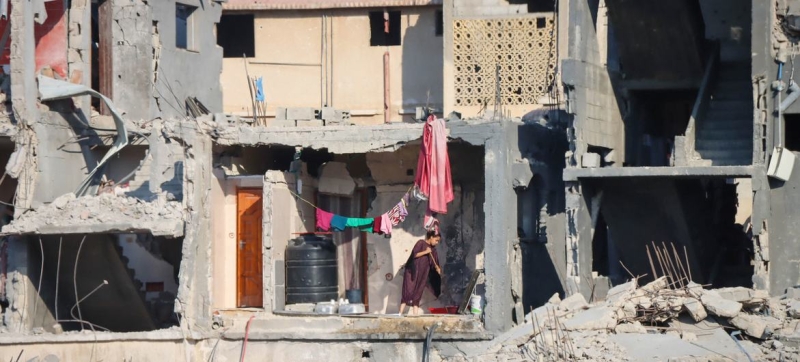
A destroyed building in Gaza. A year into the Gaza war: Unprecedented contraction of the Palestinian economy Economic developments
The war in Gaza, which has been going on for more than a year, has led to an unprecedented contraction in the labor market and the economy as a whole throughout the Occupied Palestinian Territory (OPT). According to a bulletin prepared by the International Labor Organization (ILO) and the Palestinian Central Bureau of Statistics, the combined unemployment rate in Gaza and the West Bank has risen to 51.1 percent over the past 12 months.
The unemployment rate in the West Bank averaged 34.9 percent between early October 2023 and late September 2024, while it was 79.7 percent in the Gaza Strip.
An Unprecedented Decline
The overall economic toll has also been significant, with real GDP in the OPT declining by an average of 32.2 percent over the past year. In particular, the West Bank saw a contraction of 21.7 percent, while the Gaza Strip saw a decline of 84.7 percent.
The decline is unprecedented in the OPT’s recent history. Even during the last major economic downturn in 2001, real GDP fell by 14.9 percent – less than half the scale of the current crisis, the bulletin says.
“The consequences of the war in Gaza have not only resulted in loss of life, catastrophic humanitarian conditions and physical destruction,” said Ruba Jaradat, Director of the ILO Regional Office for the Arab States. “They have fundamentally changed the socio-economic landscape of Gaza and have also had a major impact on the economy and labour market in the West Bank. The impact will be felt for generations to come.”
Poverty Levels
As the war continues, economic tensions in the OPT continue to mount, further exacerbating the problems, the report says. In the Gaza Strip, for example, virtually the entire population now lives in poverty and has extremely limited access to basic necessities.
Meanwhile, the economic downturn in the West Bank is estimated to have more than doubled the poverty rate, from 12 percent in 2023 to 28 percent by mid-2024.
The Plight
The statistics in the report reflect the plight of the enclave, with almost all productive activity in Gaza having ground to a halt due to the destruction of buildings and infrastructure and the forced displacement of Palestinians. These conditions lead either to a complete cessation of economic activity or to the prevalence of informal and irregular employment, primarily related to the provision of essential goods and services.
Read also:
Security Council briefing: Food aid stocks in northern Gaza to soon run out
In the West Bank, restrictions on the movement of people and goods, coupled with broader trade restrictions and supply chain disruptions, have had a severe impact on the economy. In addition, the situation is exacerbated by the inaccessibility of the Israeli labour market for Palestinian workers.
“The ILO and its partners are working to support recovery, prioritising infrastructure development, decent job creation, skills development and inclusive economic support in the OPT,” stressed Ruba Jaradat.
